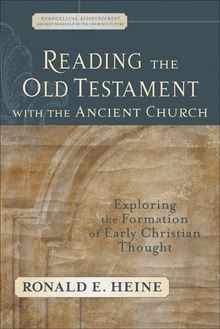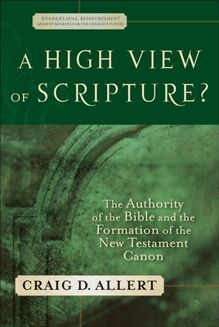Reading the Old Testament with the Ancient Church (Evangelical Ressourcement) , livre ebook
106
pages
English
Ebooks
2007
Vous pourrez modifier la taille du texte de cet ouvrage
Obtenez un accès à la bibliothèque pour le consulter en ligne En savoir plus
Découvre YouScribe en t'inscrivant gratuitement
Découvre YouScribe en t'inscrivant gratuitement
106
pages
English
Ebooks
2007
Vous pourrez modifier la taille du texte de cet ouvrage
Obtenez un accès à la bibliothèque pour le consulter en ligne En savoir plus
Publié par
Date de parution
01 septembre 2007
Nombre de lectures
0
EAN13
9781441201539
Langue
English
Publié par
Date de parution
01 septembre 2007
Nombre de lectures
0
EAN13
9781441201539
Langue
English
R EADING THE O LD T ESTAMENT WITH THE A NCIENT C HURCH
EVANGELICAL RESSOURCEMENT ANCIENT SOURCES FOR THE CHURCH S FUTURE
D. H. Williams, series editor
The Evangelical Ressourcement series is designed to address the ways in which Christians may draw upon the thought and life of the early church to respond to the challenges facing today s church.
R EADING THE O LD T ESTAMENT WITH THE A NCIENT C HURCH
Exploring the Formation of Early Christian Thought
Ronald E. Heine
2007 by Ronald E. Heine
Published by Baker Academic a division of Baker Publishing Group P.O. Box 6287, Grand Rapids, MI 49516-6287 www.bakeracademic.com
Printed in the United States of America
All rights reserved. No part of this publication may be reproduced, stored in a retrieval system, or transmitted in any form or by any means-for example, electronic, photocopy, recording-without the prior written permission of the publisher. The only exception is brief quotations in printed reviews.
Library of Congress Cataloging-in-Publication Data
Heine, Ronald E.
Reading the Old Testament with the ancient church : exploring the formation of early Christian thought / Ronald E. Heine.
p. cm. - (Evangelical ressourcement)
Includes bibliographical references.
ISBN 10: 0-8010-2777-2 (pbk.)
ISBN 978-0-8010-2777-2 (pbk.)
1. Bible. O.T.-Criticism, interpretation, etc. 2. Christian literature, Early. 3. Theology-History-Early church, ca. 30-600. I. Title. BS1171.3.H44 2007 221.609'015-dc22
2007000485
Scripture quotations labeled NRSV are from the New Revised Standard Version of the Bible, copyright 1989, Division of Christian Education of the National Council of the Churches of Christ in the United States of America. Used by permission. All rights reserved.
Scripture quotations labeled NIV are from the HOLY BIBLE, NEW INTERNATIONAL VERSION . NIV . Copyright 1973, 1978, 1984 by International Bible Society. Used by permission of Zondervan. All rights reserved.
To the memory of my friend and former colleague
Prof. Dr. Otto Betz, who was a master in using the Old Testament to interpret the New
You are not able to enter into the Holy Scriptures without a guide to show you the way.
Jerome, Epistle 53.6
C ONTENTS
Abbreviations
Preface
Introduction
1. Christian Scripture before the New Testament
2. The Struggle concerning the Law in the Second Century
3. Reimagining the Exodus
4. The Gospel in the Prophets
5. Praying the Psalms
6. Living in the Text
Epilogue
English Sources for Exegetical and Homiletical Works of the Church Fathers
A BBREVIATIONS
Modern Sources ABD Anchor Bible Dictionary ACW Ancient Christian Writers ANF The Ante-Nicene Fathers BETL Bibliotheca Ephemeridum Theologicarum Lovaniensium CCSL Corpus Christianorum: Series Latina FC The Fathers of the Church JECS Journal of Early Christian Studies JTS The Journal of Theological Studies LXX Septuagint NIV New International Version NPNF The Nicene and Post-Nicene Fathers of the Christian Church , 2series NRSV New Revised Standard Version OECS Oxford Early Christian Studies PG Migne, Patrologia Graeca WSA The Works of Saint Augustine: A Translation for the 21st Century , 3 parts ZAC/JAC Zeitschrift f r antikes Christentum/Journal of Ancient Christianity
Ancient Christian and Jewish Sources ComMt ser. Origenes Werke 11 (Die griechischen christlichenSchriftsteller), ed. E. Klostermann, E. Benz, and U. Treu Exp. Ps Augustine, Expositions of the Psalms
For the other commentary and homiletical literature of the church fathers the following abbreviation system has been used. Com (= Commentary on ) or Hom (= Homilies on ) is joined to a standard abbreviation of the biblical book, so that ComJn means Commentary on John , and HomEx means Homilies on Exodus , and so on. 4Q174 Florilegium, or Midrash on the Last Days 4Q175 Testimonia, or Messianic Anthology 4Q252 Commentary on Genesis A 4Q377 A Moses Apocryphon c 4Q521 Messianic Apocalypse 11Q5 Apocryphal Psalms (1)
PREFACE
T HE EVANGELICAL CHURCH is in danger of having a cut-flower faith. Its message of Jesus is largely severed from its roots in the Old Testament Scriptures. This is more the result of neglect than of intention. I am part of an evangelical tradition that began in the nineteenth century with the dream of restoring the church of the New Testament. The leaders of this tradition placed a great emphasis on the New Testament but neglected the Old. They failed to perceive that the Old Testament was the Bible of the church of the New Testament. 1 Many evangelical communions make that same error. None of them, including my own, would claim that the Old Testament is not Scripture or that it should not be a part of the Christian canon. Its vital connection with the church s gospel of Jesus Christ, however, is rarely understood today and even less frequently taught in the church.
This book examines how the church fathers, the leaders and teachers of the church in the first four centuries, used the Old Testament as Christian Scripture. It is not a book about the methods of interpretation used by the fathers, at least not in the usual sense of such studies. Frances M. Young is correct, I believe, when she discounts the adequacy of the approaches customarily taken in the study of the church fathers interpretation of the Bible. 2 Their interpretative methods will, of course, sometimes be an unavoidable part of the discussion but the purpose of my study does not lie in this arena. I am interested in examining the central role that the Old Testament played in the formation of Christian thinking and life in the early centuries of the church. I hope to capture the way the fathers regarded the Old Testament and some of the uses to which they put it.
While it was natural that the earliest Christians should take up the Jewish Scriptures as their Scriptures, it was also problematic. How should they, as Christians, relate to the demands of the Jewish law? How could they understand Isaiah 53 to speak of the sufferings of Jesus of Nazareth when the leaders of the synagogue understood it to refer to the sufferings of the Jewish people? Does Isaiah 7:14 refer to a virgin giving birth as the Christians held, or to a young woman giving birth as the Jews argued? These were the kinds of questions forced on the early Christians as they took up the Jewish Scriptures as their Bible.
The Old Testament provided the glasses through which the early Christians looked at Jesus of Nazareth. The doctrines they put forth regarding him and the significance of his life for humanity depend on Old Testament texts that they read in relation to him. There would have been no Christianity without the Old Testament. When the books that make up our New Testament were eventually written and elevated to the status of Scripture alongside the books of the Old Testament, the two testaments together formed the Christian Bible. The Old Testament was as much Christian Scripture as the New and was used in the same way as the New in Christian teaching and preaching. This attitude of the fathers concerning the two testaments continued through the period of the Protestant Reformation. Luther and Calvin considered both testaments to be vital for Christian teaching. It was in the post-Enlightenment period that the New Testament began to be orphaned from the Old. This process reached its climax in the critical studies of the late nineteenth and early twentieth centuries. The end result of this process has been an ambivalence about the use of the Old Testament in the church.
Various organizations and individuals contributed to the writing of this book. Chapters 2 and 3 began as lectures I delivered for the C. H. Phillips Lectures at Puget Sound Christian College in 2002. It was this series of lectures that provided the impetus for me to begin developing the seed idea that had lain dormant in my mind for several years. Chapter 2 was also presented to the Kolloquium f r Graduierte at the Eberhard Karls Universit t in T bingen, Germany, in 2004.
A stipend from the Institut zur Erforschung des Urchristentums and the European Evangelistic Society made possible a pleasant summer of research in 2004 in T bingen on the contents of chapter 4. One of the enjoyable times of that summer was a morning spent sitting at table with Prof. Otto Betz and discussing the messianic understanding in the prophets and the rabbis. I must record here my indebtedness to Prof. Betz for many aspects of my understanding of ancient Judaism. This is not the kind of indebtedness that can be footnoted, for it is not based primarily on the many books and articles that he wrote on this subject. It is the unconscious influence from my experiences with him during the ten years we worked together as co-leaders of the Kolloquium f r Graduierte at the University in T bingen. I must also thank my student assistant at Puget Sound Christian College, Ron Schaffner. He read large portions of the book as it was in preparation and caught several slips in typing and consistency. My friend and pastor, Dr. Milton Jones, read a draft of the book and made many helpful suggestions that have made it more reader friendly. I thank also Dr. D. H. Williams, the series editor, for the invitation to contribute a volume to this series and for his helpful criticisms. I, of course, take full responsibility for the flaws that remain. Finally, my wife Gillian and daughter Katrina have been supportive of and patient with my long hours of isolation with books and a computer.
REH
1 . See Ronald E. Heine, Alexander Campbell and the Old Testament, Stone-Campbell Journal (2002): 163-81.
2 . Frances M. Young, Biblical Exegesis and the Formation of Christian Culture (Cambridge: Cambridge University Press, 1997), 2.
I NTRODUCTION
M AJOR THINGS HAVE happened in Christian history when individuals have rediscovered the Bible. In one sense, it was Martin Luther s rediscovery of the Bible that led him to formulate the views that gave birth to the s



